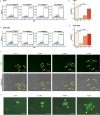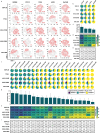A live single-cell reporter system reveals drug-induced plasticity of a cancer stem cell-like population in cholangiocarcinoma
- PMID: 39349745
- PMCID: PMC11442615
- DOI: 10.1038/s41598-024-73581-8
A live single-cell reporter system reveals drug-induced plasticity of a cancer stem cell-like population in cholangiocarcinoma
Abstract
Cancer stem cells (CSC) play an important role in carcinogenesis and are acknowledged to be responsible for chemoresistance in cholangiocarcinoma (CCA). Studying CCA CSC has been challenging, due to lack of consensus CSC markers, and to their plastic nature. Since dual expression of the core pluripotent factors SOX2/OCT4 has been shown to correlate with poor outcome in CCA patients, we selected the SOX2/OCT4 activating short half-life GFP-based live reporter (SORE6-dsCopGFP) to study CSC dynamics at the single-cell level. Transduction of five human CCA cell lines resulted in the expression of 1.8-13.1% GFP-positive (SORE6POS) cells. By live imaging, we found that SORE6POS CCA cells possess self-renewal capacity and that they can be induced to differentiate. Significantly, the SORE6POS cells were highly tumorigenic, both in vitro and in vivo, thus implicating the characteristics of primary CSCs. When we then analyzed for selected CSC-related markers, we found that the majority of both CD133+/CD44+, and CD133+/LGR5+ CCA cells were SORE6POS cells. Exposing transduced cells to standard CCA chemotherapy revealed higher growth rate inhibition at 50% (GR50s) for SORE6POS cells compared to GFP-negative (SORE6NEG) ones indicating that these CSC-like cells were more resistant to the treatment. Moreover, the chemotherapy induced SORE6POS from SORE6NEG cells, while retaining the existing SORE6POS population. Finally, treatment of transduced cells with CDK4/6 inhibitors in vitro for 3 days resulted in a lowered CSC number in the culture. Thus, applying a live reporter system allowed us to elucidate the stem cell diversity and drug-induced plasticity of CCA CSCs. These findings have clear implications for future management of such patients.
Keywords: CDK4/6 inhibitor; Cancer stem cell; Cholangiocarcinoma; Drug resistance; Live reporter.
© 2024. The Author(s).
Conflict of interest statement
The authors declare no competing interests.
Figures







Similar articles
-
Identification and Characterization of Cancer Stem-Like Cells in ALK-Positive Anaplastic Large Cell Lymphoma Using the SORE6 Reporter.Curr Issues Mol Biol. 2021 Jul 2;43(2):543-557. doi: 10.3390/cimb43020041. Curr Issues Mol Biol. 2021. PMID: 34287231 Free PMC article.
-
Mitochondrial oxidative metabolism contributes to a cancer stem cell phenotype in cholangiocarcinoma.J Hepatol. 2021 Jun;74(6):1373-1385. doi: 10.1016/j.jhep.2020.12.031. Epub 2021 Jan 21. J Hepatol. 2021. PMID: 33484774
-
MRP3-Mediated Chemoresistance in Cholangiocarcinoma: Target for Chemosensitization Through Restoring SOX17 Expression.Hepatology. 2020 Sep;72(3):949-964. doi: 10.1002/hep.31088. Epub 2020 Jul 11. Hepatology. 2020. PMID: 31863486
-
Role of Cancer Stem Cells in Cholangiocarcinoma and Therapeutic Implications.Int J Mol Sci. 2019 Aug 25;20(17):4154. doi: 10.3390/ijms20174154. Int J Mol Sci. 2019. PMID: 31450710 Free PMC article. Review.
-
Metabolic reprogramming in cholangiocarcinoma cancer stem cells: Emerging therapeutic paradigms.Cancer Lett. 2025 Jul 10;622:217714. doi: 10.1016/j.canlet.2025.217714. Epub 2025 Apr 8. Cancer Lett. 2025. PMID: 40209849 Review.
References
-
- Brown, Z. J., Ruff, S. M. & Pawlik, T. M. Developments in FGFR and IDH inhibitors for cholangiocarcinoma therapy. Expert Rev. Anticancer Ther.23, 257–264. 10.1080/14737140.2023.2176846 (2023). - PubMed
-
- Batlle, E. & Clevers, H. Cancer stem cells revisited. Nat. Med.23, 1124–1134. 10.1038/nm.4409 (2017). - PubMed
-
- Phan, T. G. & Croucher, P. I. The dormant cancer cell life cycle. Nat. Rev. Cancer. 20, 398–411. 10.1038/s41568-020-0263-0 (2020). - PubMed
MeSH terms
Substances
Grants and funding
LinkOut - more resources
Full Text Sources
Medical
Research Materials
Miscellaneous

